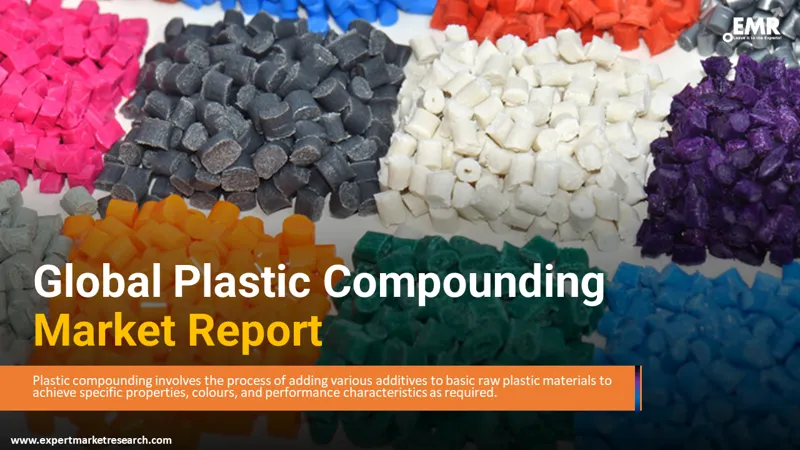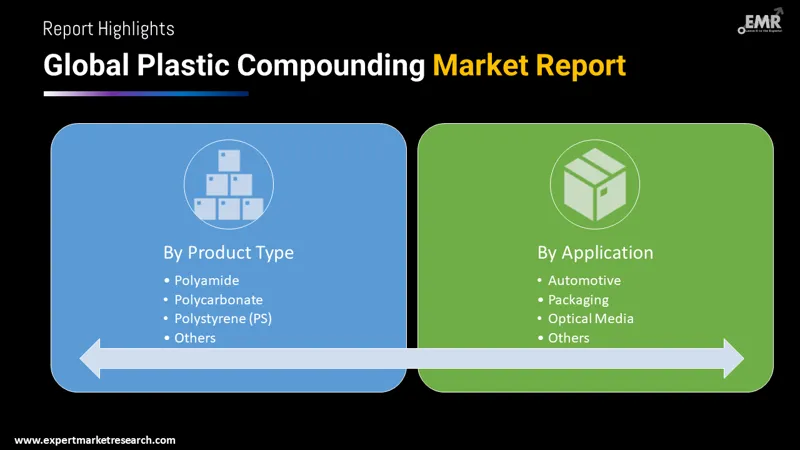
Consumer Insights
Uncover trends and behaviors shaping consumer choices today
Procurement Insights
Optimize your sourcing strategy with key market data
Industry Stats
Stay ahead with the latest trends and market analysis.
The global plastic compounding market size attained a value of approximately USD 72.72 Billion in 2025. The market is further expected to grow in the forecast period of 2026-2035 at a CAGR of 7.10%, reaching a value of around USD 144.39 Billion by 2035.
Base Year
Historical Period
Forecast Period
Compound Annual Growth Rate
7.1%
Value in USD Billion
2026-2035
*this image is indicative*
| Global Plastic Compounding Market Report Summary | Description | Value |
| Base Year | USD Billion | 2025 |
| Historical Period | USD Billion | 2019-2025 |
| Forecast Period | USD Billion | 2026-2035 |
| Market Size 2025 | USD Billion | 72.72 |
| Market Size 2035 | USD Billion | 144.39 |
| CAGR 2019-2025 | Percentage | XX% |
| CAGR 2026-2035 | Percentage | 7.10% |
| CAGR 2026-2035 - Market by Region | Asia Pacific | 8.2% |
| CAGR 2026-2035 - Market by Country | India | 8.4% |
| CAGR 2026-2035 - Market by Country | China | 7.8% |
| CAGR 2026-2035 - Market by Product Type | Polypropylene (PP) | 8.1% |
| CAGR 2026-2035 - Market by Application | Automotive | 8.3% |
| Market Share by Country 2025 | France | 3.2% |
Increasing applications of plastic compounding in the building and construction sector is contributing to the growth of the plastic compounding market. Rapid urban development activities, rising standards of living, and globalisation are some of the crucial market trends, escalating the incorporation of plastic compounding across construction projects. Meanwhile, plastics compounding is also gaining traction in the healthcare sector for manufacturing medical devices. The increasing healthcare expenditure across emerging economies and growing sophistication of medical equipment are expanding the opportunities for the market for plastic compounding. The flexibility and strength of plastic compounding is expected to heighten its incorporation in advanced MedTech devices further.

Read more about this report - REQUEST FREE SAMPLE COPY IN PDF
The Asia Pacific plastic compounding market is expected to hold a significant share of the global market for plastic compounding. This is on account of the emergence of plastic manufacturers like BASF SE, and SABIC, among others, coupled with the economic environment of the region. The surging manufacturing industry is also likely to drive the demand for industrial machinery, automotive, packaging, construction, and electrical and electronics sectors across the region.
Meanwhile, the Europe plastic compounding market is anticipated to witness steady growth in the global market for plastic compounding. As a significant consumer and producer of automobiles, consumer goods, and packaging materials, the region is expected to witness robust market growth of plastic compounding.
Global Plastic Compounding Market Report and Forecast 2026-2035 offers a detailed analysis of the market based on the following segments:
Market Breakup by Product Type
Market Breakup by Application
Market Breakup by Region

Read more about this report - REQUEST FREE SAMPLE COPY IN PDF
| CAGR 2026-2035 - Market by | Country |
| India | 8.4% |
| China | 7.8% |
| Canada | 6.7% |
| Germany | 5.8% |
| Italy | 5.0% |
| USA | XX% |
| UK | XX% |
| France | XX% |
| Japan | 4.9% |
| Australia | XX% |
| Saudi Arabia | XX% |
| Brazil | XX% |
| Mexico | XX% |
On the basis of application, the automotive segment is expected to drive the market growth for plastic compounding during the forecast period. Surging integration of plastics in automotive components as opposed to alloys and metals, has increased the demand for plastic compounding from the automotive segment.
China, India, and Brazil are the major production hubs for automobiles and are also fast-growing economies that are further expected to gain momentum and drive growth for plastic compounding. Meanwhile, the growing demand for plastic compounding in infrastructure development among various constructional activities is likely to boost the market for plastic compounding further.
The report presents a detailed analysis of the following key players in the global plastic compounding market, looking into their capacity, market shares, and latest developments like capacity expansions, plant turnarounds, and mergers and acquisitions:
The comprehensive report looks into the macro and micro aspects of the market. The EMR report gives an in-depth insight into the market by providing a SWOT analysis as well as an analysis of Porter’s Five Forces model.




*While we strive to always give you current and accurate information, the numbers depicted on the website are indicative and may differ from the actual numbers in the main report. At Expert Market Research, we aim to bring you the latest insights and trends in the market. Using our analyses and forecasts, stakeholders can understand the market dynamics, navigate challenges, and capitalize on opportunities to make data-driven strategic decisions.*
Get in touch with us for a customized solution tailored to your unique requirements and save upto 35%!
In 2025, the global market attained a value of approximately USD 72.72 Billion.
The market is assessed to grow at a CAGR of 7.10% between 2026 and 2035.
The market is estimated to witness healthy growth in the forecast period of 2026-2035, reaching a value of around USD 144.39 Billion by 2035.
The major market drivers include the thriving automotive industry, increasing demand for specialised plastics, and rising substitution of materials such as natural rubber, wood, metals, glass, and concrete with plastic.
The key plastic compounding market trends include the surging usage of plastic in use in various industrial applications and the high demand for PET in the packaging industry.
The major regions in the market are Asia Pacific, North America, Europe, Latin America, and the Middle East and Africa.
The various product types of plastic compounding in the market include polyethylene (PE), polypropylene (PP), thermoplastic vulcanizates (TPV), thermoplastic polyolefins (TPO), poly vinyl chloride (PVC), polystyrene (PS), polyethylene terephthalate (PET), polybutylene terephthalate (PBT), polyamide, polycarbonate, and acrylonitrile butadiene styrene (ABS), among others.
The different applications of plastic compounding in the market include automotive, building and construction, electrical and electronics, packaging, consumer goods, industrial machinery, medical devices, and optical media, among others.
The major players in the market are BASF SE, Arkema Group, AKRO-PLASTIC GmbH, DuPont, LyondellBasell Industries Holdings B.V., Aurora Plastics LLC, SABIC, Solvay SA, Evonik Industries AG, Kuraray Co., Ltd., LANXESS AG, Covestro AG, The Dow Chemical Company, Celanese Corporation, Avient Corporation, Washington Penn, Teijin Limited, and EuroPlas( European Plastics Joint Stock Company), among others.
Explore our key highlights of the report and gain a concise overview of key findings, trends, and actionable insights that will empower your strategic decisions.
| REPORT FEATURES | DETAILS |
| Base Year | 2025 |
| Historical Period | 2019-2025 |
| Forecast Period | 2026-2035 |
| Scope of the Report |
Historical and Forecast Trends, Industry Drivers and Constraints, Historical and Forecast Market Analysis by Segment:
|
| Breakup by Product Type |
|
| Breakup by Application |
|
| Breakup by Region |
|
| Market Dynamics |
|
| Competitive Landscape |
|
| Companies Covered |
|
Single User License
One User
USD 3,999
USD 3,599
tax inclusive*
Datasheet
One User
USD 2,499
USD 2,249
tax inclusive*
Five User License
Five User
USD 4,999
USD 4,249
tax inclusive*
Corporate License
Unlimited Users
USD 5,999
USD 5,099
tax inclusive*
*Please note that the prices mentioned below are starting prices for each bundle type. Kindly contact our team for further details.*
Flash Bundle
Small Business Bundle
Growth Bundle
Enterprise Bundle
*Please note that the prices mentioned below are starting prices for each bundle type. Kindly contact our team for further details.*
Flash Bundle
Number of Reports: 3
20%
tax inclusive*
Small Business Bundle
Number of Reports: 5
25%
tax inclusive*
Growth Bundle
Number of Reports: 8
30%
tax inclusive*
Enterprise Bundle
Number of Reports: 10
35%
tax inclusive*
How To Order

Select License Type
Choose the right license for your needs and access rights.

Click on ‘Buy Now’
Add the report to your cart with one click and proceed to register.

Select Mode of Payment
Choose a payment option for a secure checkout. You will be redirected accordingly.
Gain insights to stay ahead and seize opportunities.

Get insights & trends for a competitive edge.

Track prices with detailed trend reports.

Analyse trade data for supply chain insights.

Leverage cost reports for smart savings

Enhance supply chain with partnerships.

Connect For More Information
Our expert team of analysts will offer full support and resolve any queries regarding the report, before and after the purchase.
Our expert team of analysts will offer full support and resolve any queries regarding the report, before and after the purchase.
We employ meticulous research methods, blending advanced analytics and expert insights to deliver accurate, actionable industry intelligence, staying ahead of competitors.
Our skilled analysts offer unparalleled competitive advantage with detailed insights on current and emerging markets, ensuring your strategic edge.
We offer an in-depth yet simplified presentation of industry insights and analysis to meet your specific requirements effectively.
Share